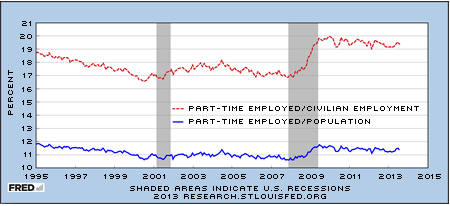Ask an Economist
David Wiczer is an economist at the St. Louis Fed. He loves running, listening to music and going to concerts on the off chance that, one day, he'll be able to say, "I saw them when they were just starting." His research interests include macro and labor economics, especially occupational choice and inequality.
Q. Why has part-time employment grown recently?
A.Part-time employment usually increases during a recession. But such employment tends to fall when the recession is over, and that hasn't happened following the recent downturn. The figure below illustrates two ways in which this phenomenon can be measured: part-time employment as a fraction of total population and part-time employment as a fraction of employment. Let's look at the latter more closely. In December 2007, when the recession began, 16.9 percent of those working usually worked part time. By the time the recession ended, in June 2009, that share had risen to 19.6 percent. Even though the overall employment situation has improved, the share of part-time employment has stayed persistently high, with the latest reading (in August 2013) of 19.4 percent.
One explanation for this increase is that job creation in the expansion has been very asymmetric. The industries and occupations where most of the growth has happened have more part-time workers. This explanation is related to what economists call "job polarization." Since the 1970s, a large part of the job growth has been in either low-end occupations or high-end occupations, and these low-end occupations often have more part-time work.
Another explanation for the increase in part-time work stems from the propensity for people in some age groups to be employed part-time. Those who are younger than 25 or older than 55 tend to be more cyclical in their labor force participation. In recessions, they leave the labor force at a higher rate, and in expansions they enter it again. These people will often work part-time jobs.
Some people have pointed to the Affordable Care Act as another cause for this increase. The claim is that employers are creating part-time jobs so as to remain under the 50 full-time worker cutoff for the employer mandate. So far, there are no data suggesting that this is true. There are countries in Europe where higher fixed costs of employing people have created a two-tier labor market. However, it is too early to make a definitive statement regarding this possibility in the U.S.
Views expressed in Regional Economist are not necessarily those of the St. Louis Fed or Federal Reserve System.
For the latest insights from our economists and other St. Louis Fed experts, visit On the Economy and subscribe.
Email Us


